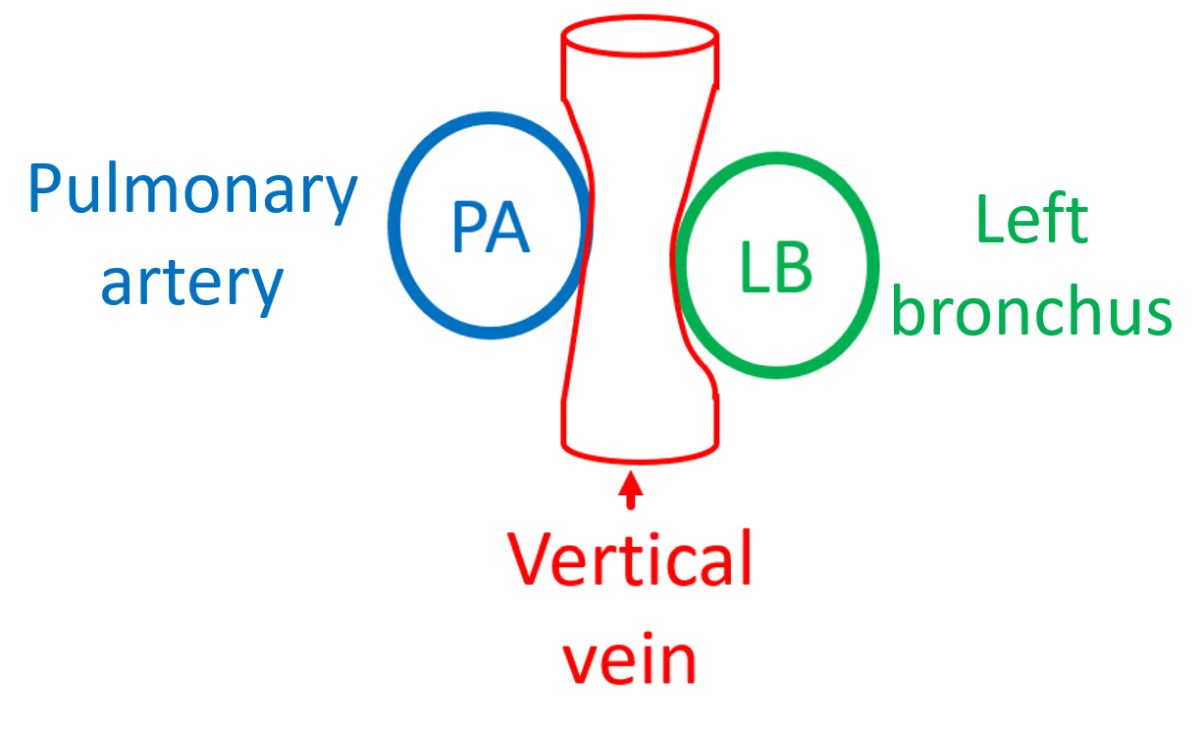Hemodynamic vise
What is hemodynamic vise?
The vertical vein in total anomalous pulmonary venous connection passes between the pulmonary artery and the left bronchus and gets compressed when the pulmonary artery pressure goes up (hemodynamic vise).

This produces pulmonary venous obstruction and increased pulmonary venous pressure, which in turn causes further elevation of pulmonary artery pressure leading to enhanced compression of the vertical vein. A vicious cycle of increasing pulmonary venous and arterial pressures is setup.
A case of hemodynamic vise in obstructed TAPVC has been reported by Arun Gopalakrishnan, Kavassery Mahadevan Krishnamoorthy and Ajitkumar Valaparambil [1].
HV of right sided vertical vein has also been reported [2]. Pulmonary veins were initially draining into a common venous chamber and the vertical vein was ascending on the right side behind the right pulmonary artery causing HV. This was a 5 hour old baby who was blue and breathless. After echo and CT confirmation, the baby was taken for emergency surgery. Baby had an uneventful recovery after surgical correction and was discharged at 2 weeks.
An unusual report of pulmonary venous obstruction from two separate anomalies has also been documented in literature [3]. The child was operated for cor triatriatum at 19 months, but died on second post operative day. At necropsy, it was found that pulmonary veins from left lung and a vein from the upper half of the lower lobe of right lung joined a common channel. This anomalous vein joined the lateral end of the left innominate vein. This vein ascended between the left pulmonary artery and left bronchus which formed a hemodynamic vise. Veins from the remaining portion of right lung joined the accessory left atrial chamber. This baby had coarctation of aorta also, which was operated when the baby was 2 months old.
References
- Arun Gopalakrishnan, Kavassery Mahadevan Krishnamoorthy, Ajitkumar Valaparambil. J Echocardiogr. 2019 Sep;17(3):164-166.
- Atul Achyut Kalantre, Bhavik Champaneri, Brijesh Kottayil, Balu Vaidyanathan. “Hemodynamic Vice” of the Right-Sided Ascending Vertical Vein in the Setting of Supracardiac Total Anomalous Pulmonary Venous Connection in a Neonate: Anatomic-embryological Correlation. Ann Pediatr Cardiol. Jan-Apr 2017;10(1):104-106.
- Shone JD, Anderson RC, Amplatz K, Varco RL, Leonard AS, Edwards JE. Pulmonary venous obstruction from two separate coexistent anomalies: Subtotal pulmonary venous connection to cor triatriatum and subtotal pulmonary venous connection to left innominate vein. Am J Cardiol. 1963;11(4):52-531.

